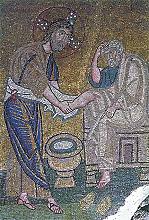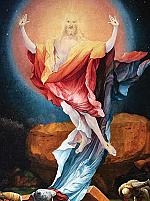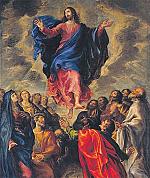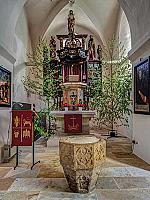The Christian year
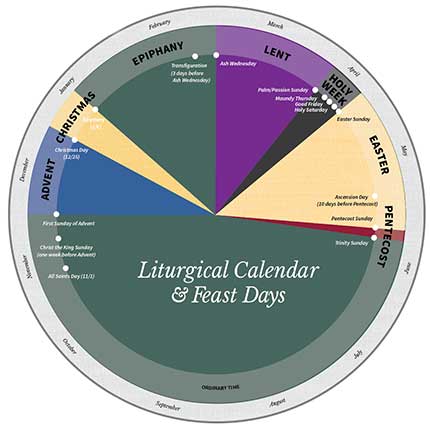
[ABOVE: Wheel of church year, by Doug Johnson]
The colors and terms on this diagram represent a Western Protestant version of the Christian year; differences in Orthodox and Catholic calendars are presented below.
The Roman Catholic Church observes the same seasons and, with one exception, colors. There are some small differences. For instance, Catholics celebrate the Transfiguration on August 6 rather than on the Sunday before Ash Wednesday. Catholic churches also generally use purple instead of blue for Advent. (Some Protestants do too.)
Some important Catholic feasts, referred to as “solemnities,” do not appear on this calendar. Many of the feast days you do see are solemnities (excluding Palm Sunday, Ash Wednesday, the Transfiguration, and the first Sunday of Advent), but Catholics would add those in honor of the Virgin Mary on January 1, St. Joseph on March 19, the Annunciation on March 25, Corpus Christi on the Thursday after Trinity, the Sacred Heart eight days after Corpus Christi, the nativity of St. John the Baptist on June 24, Sts. Peter and Paul on June 29, the Assumption of Mary on August 15, and the Immaculate Conception on December 8.
The Eastern Orthodox church differs from this diagram in greater ways, though the basic shape of the liturgical seasons remains the same. Here’s how the Christian year in Orthodoxy diverges from this calendar:
The liturgical calendar begins on September 1 (rather than, as in the West, the first Sunday of Advent). A different method is used in the East to set the date of Easter, so it and the feasts depending on it often occur at different times than their Western counterparts. Similar to Catholic solemnities, there are 12 Great Feasts that shape the church year (see p. 45). Some have Western equivalents.
The term “Advent” is not used. The Nativity Fast runs from November 15 to December 25. The color is red. As in the West, white and gold are used for Christmastide, and the season ends with Epiphany on January 6 (more often referred to as Theophany in the Eastern church). The Sundays after Theophany run until Lent, and gold is used.
Lent begins on Clean Monday following three weeks of Pre-Lent; in addition to purple, the Orthodox also use black in Lent. Holy Week is explicitly a separate season not counted in the Lenten 40 days. The color is green for Palm Sunday and red or black for the rest of the week.
Orthodox Eastertide (Pascha), like Western Eastertide, runs for 50 days, celebrates the Ascension on the 40th day, and uses white. Pentecost Sunday in the East also celebrates the Trinity, and no separate Trinity Sunday is observed. Pentecost’s colors are green for the day and gold for the whole season of Sundays afterward. (Ordinary Time is a Western concept.) The Eastern church celebrates All Saints’ Day the Sunday after Pentecost. Christ the King, a Western feast, is not celebrated. CH
By Jennifer Woodruff Tait
[Christian History originally published this article in Christian History Issue #156+ in 2025]
Jennifer Woodruff Tait is Senior Editor of CH magazineNext articles
The holiest week of the year
The week between Palm Sunday and Easter has traditionally been considered the holiest week of the church year.
Jennifer Woodruff TaitCelebrating the risen Savior
Jesus’s Resurrection is the event on which everything else about the Christian faith depends.
Jennifer Woodruff TaitAscension
He ascended into heaven and is seated at the right hand of God the Father Almighty.
Jennifer Woodruff TaitSupport us
Christian History Institute (CHI) is a non-profit Pennsylvania corporation founded in 1982. Your donations support the continuation of this ministry
Donate



